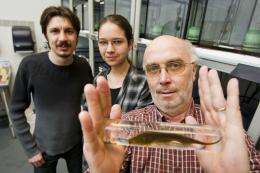A humble fish helps us understand our own brains

(Medical Xpress) -- Recent findings from the Laboratory of Neurobiology at Northeastern, led by biology professor and chair Günther Zupanc, and published online in the scientific journal Neuroscience, demonstrate the mechanism by which new neurons find their ultimate home — research that Zupanc hopes will offer insight into the regenerative potential of the human brain.
In 1989, scientists discovered that two areas of the human brain — the hippocampus and the olfactory bulb — are capable of generating neurons during adulthood. In the last decade, adult stem-cell research has shown that latent stem cells also exist in other regions.
In principle, this information could be used to help the brain cure itself by replacing neurons lost to injury with new, adult-born neurons. However, despite the work of thousands of research programs, such attempts have failed thus far.
“Key to the development of such replacement therapies is to better understand what limits the regenerative potential of the human brain,” said Zupanc.
His team, which includes Northeastern research associates Ruxandra Sîrbulescu and Iulian Ilies, believes that exploring the regenerative capacities of other species can lend insight into the neurological system of mammals. “If there are certain molecules that are missing in the system, then you can search as much as you want, you will never find them,” said Zupanc.
Bony fish have the ability to grow new brain tissue or part of the spinal cord after a predatory attack. This evolutionary strategy makes them prime candidates for studying neuronal regeneration, he said.
If scientists could induce the mammalian system to mimic the cellular behavior of the fish system, it could allow people to heal from traumatic brain and spinal-cord injuries in a matter of weeks, Zupanc said. But neuronal regeneration, which has been demonstrated in stroke patients, does not itself lead to recovery.
New neurons must migrate to a different area of the brain to become functional, Zupanc explained. His recent investigations with teleost fish explore the process of neuronal migration, which only occurs with proper guidance, he said. Until now, researchers have not known how new neurons in the adult fish brain find their way to their target areas, where they integrate into the network of existing neurons and become functional.
The team found that a different cell type — the radial glia — guides new neurons along a scaffold from their birthplace to their ultimate home. The same phenomenon has been observed in human embryonic development. But while teleost fish retain this ability into adulthood, humans do not.
Without a full understanding of how neurons develop functionality, these findings will remain in the lab as interesting research results. Zupanc hopes his investigations with fish will add important insights required to help human patients with neurological injuries and diseases.













